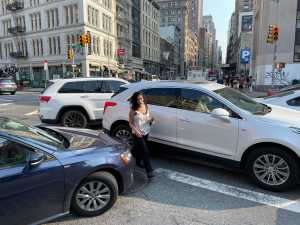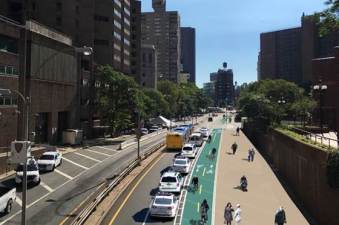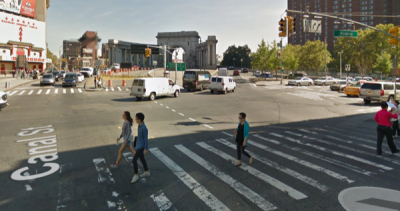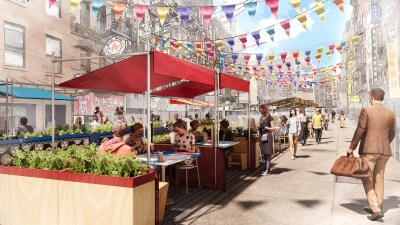Chinatown’s Doyers Open Street to Become a Car-Free Plaza
Narrow Doyers, between Pell and the Bowery, will be fully pedestrianized this fall.
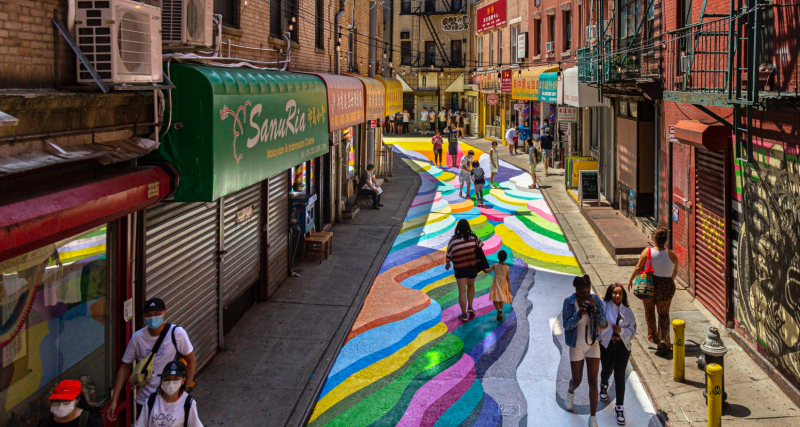
Advertisement: Used Dutch Bikes is your one-stop-shop for authentic Dutch bicycles. Choose from classic “grandma bikes” to modern seven-speeds that can haul three kids without breaking a sweat. We carry authentic brands like Gazelle, Batavus, BSP, Burgers, Cortina, and more — available in the USA for the first time!
An open street in Chinatown will become a fully pedestrianized plaza this fall.
The Department of Transportation will build on the success of its Covid-era open space initiative on Doyers Street with a full conversion, featuring gravel, markings, and planters. The agency will also improve the surrounding streets by shortening a Bowery crossing; converting two-hour metered parking on Bowery between Doyers and Pell to three-hour commercial metered parking for loading, pick-up and drop-off, and will convert the daytime “No Parking” area on Bowery between Mott and East Broadway to two-hour metered parking.
It’s all contained in a presentation [PDF] made to Manhattan Community Board 3 earlier this month.
“DOT is proud to build on the success of our Open Streets with proposals to formalize spaces like the Doyers Open Street as a permanent pedestrian plaza,” said DOT spokesman Vin Barone. “The Doyers open street is a must-visit Chinatown destination that is remarkably popular among visitors and local businesses alike.”
Doyers is a natural for becoming a pedestrian enclave; it connects Bowery to Pell Street, even though Pell Street is accessible directly from the Bowery anyway; as such, it adds no value for motorists (see map below). In fact, given where it is, Doyers Street never should have been designated as a street for cars. Chinatown, a crowded area built before the advent of the automobile, holds little open or green space, and thus the new plaza is sorely needed.
The narrow, curving mini-roadway has long been eyed for pedestrianization. In 2017, the bustling block of restaurants and small shops began participating in the DOT’s Seasonal Streets program, which closes certain streets to car traffic during the warm months in order to “try out” pedestrianization for road users and businesses. In 2020, Doyers became an open street, pedestrianized during daylight hours in order to give the neighborhood space for much-needed outdoor socializing and arts programming during the pandemic.
According to CB3’s Planning Department profile and needs statement, the district’s 1.7 square miles has a population of 163,141, or slightly more than 97,000 people per square mile. It is “underserved in terms of open space, with less than the city-recommended 2.5 acres of open space per 1,000 residents.”
“Chinatown is what Jacob Riis wrote about in ‘How the Other Half Lives’ — an area full of tenements that does not have any outdoor space,” said Wellington Chen, the executive director of the Chinatown Partnership, which is working with the local business improvement district and the city to create the plaza.

He said that the district’s alleys and tiny restaurants and shops have strained mightily under Covid-19. Now, two and a half years after the initial surge and with the subvariant surging, merchants and residents well understand the value of having permanent outdoor space for shoppings and dining.
“It’s healthier and safer for both shopkeepers and customers,” he said, expressing amazement that al fresco dining is controversial in New York, given that in places as diverse as Paris and the seaport of Singapore customers pay a premium to eat out of doors.
There have been wrinkles: One restaurant antagonized neighbors by hogging space on the block for seating, creating a sidewalk bottleneck, according to the local blog Bowery Boogie.
The coming Doyers Plaza is only the latest instance of a BID working with the city to create car-free or car-light outdoor spaces. BIDs have spearheaded pedestrianization efforts across the city, including on Broadway at Herald, Times and Madison squares; in the old Printing District on the far West Side, and in Downtown Brooklyn on Fulton Street. The public-private partnerships, which unite merchants and property owners, who pay a fee to belong, enthusiastically champion pedestrianization for its benefits for foot-traffic and thus profits. Even though some fault the BIDs for privatizing public space, they undeniably are leading post-Covid streetscape improvements.
“New York City is on the road to rapid economic recovery due in part to our important partnership with our business improvement districts,” Small Business Services Commissioner Kevin Kim said earlier this year. “From new initiatives to clean up our sidewalks, to the transformation of streets into vibrant public spaces, BIDs in all five boroughs play a critical role in our economic comeback.”

The pedestrianization of swathes of Chinatown would form the natural complement to the pedestrianization of the Financial District, which lies below it and proceeds to the southern tip of the island. The Financial District Neighborhood Association has pushed such a plan for several years, but the city has dawdled because of the many city officials and workers who ply the area’s streets in placarded city cars, parking illegally and creating hazards.
The department is working to formalize several open streets around the city into plazas, including 34th Avenue in Jackson Heights, Queens; and Berry Street and Underhill Avenue in Prospect Heights, Brooklyn. It turned the western end of Dyckman Street in upper Manhattan into a plaza late last year.
